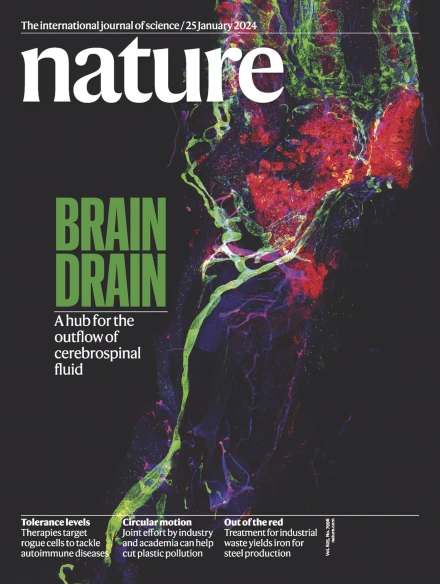复制解旋酶解绕DNA的结构动力学
IF 48.5
1区 综合性期刊
Q1 MULTIDISCIPLINARY SCIENCES
引用次数: 0
摘要
六聚体解旋酶是核苷酸驱动的分子机器,它解除DNA,启动生命所有领域的复制。尽管经过了几十年的深入研究,它们功能的几个关键方面仍未得到解决:DNA链分离的位置和机制,解绕繁殖的机制,以及核苷酸水解与DNA运动之间的动态关系。在这里,使用冷冻电子显微镜(cryo-EM),我们发现猿猴病毒40大肿瘤抗原(LTag)解旋酶在复制起点以头对头六聚体的形式组装,在两个对称位置熔化DNA以建立双向复制分叉。通过连续的异质性分析2,我们描述了催化条件下分叉DNA上LTag的构象景观,证明了驱动DNA易位和解绕的协调运动。我们表明,解旋酶将跟踪链拉过沿中心通道排列的dna结合环,同时将非跟踪链引导出后方,这是一个循环过程。ATP水解起着“熵开关”的作用,去除易位障碍,而不是直接为DNA运动提供动力。我们的结构显示了核苷酸周转和亚基运动之间的变构耦合,使DNA解绕,同时为分离的链保持专用的退出路径。这些发现为从病毒到真核系统的复制叉的建立和发展提供了一个全面的模型。更广泛地说,他们介绍了atp依赖酶通过熵驱动变构实现有效机械功的机制的基本原理。本文章由计算机程序翻译,如有差异,请以英文原文为准。


Structural dynamics of DNA unwinding by a replicative helicase
Hexameric helicases are nucleotide-driven molecular machines that unwind DNA to initiate replication across all domains of life. Despite decades of intensive study, several critical aspects of their function remain unresolved1: the site and mechanism of DNA strand separation, the mechanics of unwinding propagation, and the dynamic relationship between nucleotide hydrolysis and DNA movement. Here, using cryo-electron microscopy (cryo-EM), we show that the simian virus 40 large tumour antigen (LTag) helicase assembles in the form of head-to-head hexamers at replication origins, melting DNA at two symmetrically positioned sites to establish bidirectional replication forks. Through continuous heterogeneity analysis2, we characterize the conformational landscape of LTag on forked DNA under catalytic conditions, demonstrating coordinated motions that drive DNA translocation and unwinding. We show that the helicase pulls the tracking strand through DNA-binding loops lining the central channel, while directing the non-tracking strand out of the rear, in a cyclic process. ATP hydrolysis functions as an ‘entropy switch’, removing blocks to translocation rather than directly powering DNA movement. Our structures show the allosteric couplings between nucleotide turnover and subunit motions that enable DNA unwinding while maintaining dedicated exit paths for the separated strands. These findings provide a comprehensive model for replication fork establishment and progression that extends from viral to eukaryotic systems. More broadly, they introduce fundamental principles of the mechanism by which ATP-dependent enzymes achieve efficient mechanical work through entropy-driven allostery. Cryo-electron microscopy structures of DNA helicases in various conformations provide insight into an ATP-hydrolysis-dependent ‘entropy switch’ that drives unwinding of DNA for replication, with probable conservation across viral and eukaryotic systems.
求助全文
通过发布文献求助,成功后即可免费获取论文全文。
去求助
来源期刊

Nature
综合性期刊-综合性期刊
CiteScore
90.00
自引率
1.20%
发文量
3652
审稿时长
3 months
期刊介绍:
Nature is a prestigious international journal that publishes peer-reviewed research in various scientific and technological fields. The selection of articles is based on criteria such as originality, importance, interdisciplinary relevance, timeliness, accessibility, elegance, and surprising conclusions. In addition to showcasing significant scientific advances, Nature delivers rapid, authoritative, insightful news, and interpretation of current and upcoming trends impacting science, scientists, and the broader public. The journal serves a dual purpose: firstly, to promptly share noteworthy scientific advances and foster discussions among scientists, and secondly, to ensure the swift dissemination of scientific results globally, emphasizing their significance for knowledge, culture, and daily life.
 求助内容:
求助内容: 应助结果提醒方式:
应助结果提醒方式:


